Dividend Aristocrats - buy, keep and earn [Guide]
Nowadays, growth companies are triumphant, which in recent years have outclassed value companies in terms of the achieved rate of return. However, investing in companies characterized by dynamic growth of revenues and profits has a certain disadvantage - you have to believe that the company's product or service is truly unique and that the company has a significant advantage over its competitors. In the case of growth companies, their current valuations are only a discount to the realization of the optimistic scenario. When the company's growth slows down, the likelihood of such a scenario materializing decreases sharply. This often results in a significant decrease in the company's growth capitalization. For this reason, some investors prefer to invest in "stable and peaceful" companies that pay dividends. There is a special name for companies which for many years not only pay dividends, but also increase their value. Such companies are called Dividend Aristocrats.
Dividend Aristocrat is a term coined for American companies that have continuously increased the level of dividends paid for 25 years. The "Książkowo" company should also be a component of the S&P 500 index. There is even an index grouping these types of companies. This is the S&P 500 Dividend Aristocrat Index.
However, investors do not have to be so restrictive in investing only in companies the S&P 500 index. Instead, the investor may consider that the dividend aristocrat is any company that has continuously increased its dividend payout for 25 years. Another term is also worth mentioning: Dividend King. These are companies that have been increasing dividends continuously for 50 years.
What is TSR (Total Shareholders Return)?
TSR is a measure that is helpful in determining the investor's return on a given stock or the entire portfolio. The aforementioned measure calculates the rate of return achieved by the investor on a given portfolio of shares. The formula is as follows:
TSR = ((Current Price - Purchase Price) + Dividends) / Purchase Price
The investor purchased shares in XYZ and purchased it for PLN 60 apiece. The current price is PLN 61. At the same time, the investor received PLN 7 per share in dividends during the year. This gives a profit on share appreciation of PLN 1. At the same time, a PLN 7 dividend should be added. This gives PLN 8 of profit from the original investment of PLN 60. As a result, TSR is 13,33%, even though the share appreciation itself was only 1,67%.
In the case of dividend aristocrats, there is a double mechanism: an increase in the value of shares and an increase in the amount of dividends per share.
Dividend aristocrats - advantages
Why do companies pay dividends? First, for a company to be able to pay dividends, it must meet two conditions:
- generate profits in the past,
- have sufficient financial resources to pay the dividend.
These two points don't always come in pairs. Sometimes the net profit appears as a result of an asset revaluation, which is accounting for profit but does not generate extra cash. In such a situation, the company may pay dividends. However, it will have to either lower the cash level or obtain financing (external or internal). While such activities may occur in the short term, carrying out such practices for 25 years is extremely difficult.
As a result, the presence in such a list gives a signal that the company has been able to generate large amounts of free cash flow (FCF) for many years. The dividend aristocrat, as a rule, from the generated cash, is able to service the debt, cover investment expenses, take over competitors and generate "surplus" cash. The company partially transfers these surpluses to shareholders, e.g. in the form of dividends.
At the same time, the company is able to generate surpluses also in times of economic slowdown or even a strong recession. As a result, finding such companies is very difficult. This means that the dividend aristocrat can boast a stable business, strong market position and, as a rule, sell goods and services that are "Recession resistant". Such companies include, for example, companies managing the water supply network or companies from the healthcare industry.
Another advantage of investing in dividend companies is that you get an additional cash flow each year that can be used either for consumption or for reinvestment in a stock portfolio. The dividend aristocrats are a kind of "certainty" for long-term investments, but not without their drawbacks.
Dividend aristocrats - disadvantages
However, companies that regularly pay dividends also have their downsides. Since the company pays dividends to shareholders, it believes that it is not able to reinvest excess cash in the business. This could mean that:
- management only thinks in the short term and sees no potential investment - in such a situation, the management board wastes the company's potential to diversify its activities or introduce a new, interesting product or service.
- the management board is conservative and prefers not to risk (fear of a failed investment) - in such a situation, the company turns into a "bond-company". It pays regular dividends, but does not scale up its operations in fear of making a mistake. In such a situation, the company limits itself and does not use profitable activities to further increase the scale of operations.
- there is no chance of scaling your business and achieving a satisfactory rate of return on invested capital - this is a situation where, despite the willingness of the management board to increase the scale of operations, the available investments do not guarantee a high ROIC. In such a situation, it is a reasonable decision of the management board, which does not want to take over competitors at too high a price (which destroys the company's value) or there is no room for growth. In such a situation, returning cash to shareholders is a reasonable choice.
Regular payment of dividends means that the potential for dynamic development of the company is very limited and the company is not able to "scale" and take full advantage of the magic of compound interest.
Sometimes the status of a dividend aristocrat can be an "anchor" for companies. Due to the fact that the management boards of companies do not want to negatively write themselves in the history of the company, the information about abandoning the tradition of regularly increasing dividends may be a "stain on the CV". For this reason, some firms may be irrational and continue to increase dividends during periods of medium-term deterioration in prospects.
An example would be Chevron. The years 2011 - 2014 were very "fat" for companies from this market. Chevron earned $ 93,7 billion in the period and paid out $ 28,4 billion in dividends. In those years, the payout ratio fluctuated in individual years in the range of 23% - 41%. So it was a "healthy" level. However, falling commodity prices meant that in 2015-2020 the company generated "only" $ 25,5 billion in net profit. At the same time, the company did not stop paying dividends, and regularly increased the DPS (dividend per share) ratio. As a result, over those six years, it paid out dividends worth $ 51,2 billion, which is twice as much as the profits. At the same time, the company, despite the CAPEX reduction, continued to carry out expensive investment projects (on average $ 13 billion annually in 2015-2020). It is therefore not surprising that the company's indebtedness has increased significantly. In 2011, the company had a net debt of $ -10 billion (more cash and cash equivalents than debt). At the end of 2020, net debt increased to $ 42,5 billion.
Another disadvantage of investing in dividend companies may be the effect of double taxation of the dividend. The first level is the CIT paid by the corporation (if there is no tax shield). After the dividend is paid, the investor will have to pay capital gains tax (if there is no tax shield or it is not a preferential account, e.g. retirement). As a result, it is more tax advantageous for the company to purchase shares.
Dividend aristocrats - examples of companies
Below are some examples of companies that belong to dividend aristocrats.
Colgate - Palmolive
The company's history dates back to 1806, when William Colgate began producing soap and candles in New York. In 1928, Palmolive-Peet acquired Colgate to form the Colgate-Palmolive-Peet company. In 1953, the company was renamed Colgate-Palmolive. Currently, it is a company with one of the most famous consumer brands in the United States and Europe. The company deals with, among others production of toothpaste, soap, shower gels, shampoos, deodorants, household chemicals, etc. The company sells its products through stores, wholesalers and distributors. Among the well-known brands, the following can be mentioned: Colgate, Palmolive, Elmex, Meridol, Ajax or Soft Soupline, PCA Skin.
| $ million | 2017 | 2018 | 2019 | 2020 |
| revenues | 15 454 | 15 544 | 15 693 | 16 471 |
| Operational profit | 3 925 | 3 759 | 3 614 | 3 789 |
| Operating margin | 25,40% | 24,18% | 23,03% | 23,00% |
| Net profit | 2 024 | 2 400 | 2 367 | 2 695 |
| EPS ($) | 2,30$ | 2,76$ | 2,76$ | 3,15$ |
| DPS ($) | 1,59$ | 1,66$ | 1,71$ | 1,75$ |
| Payout ratio | 69% | 60% | 62% | 56% |
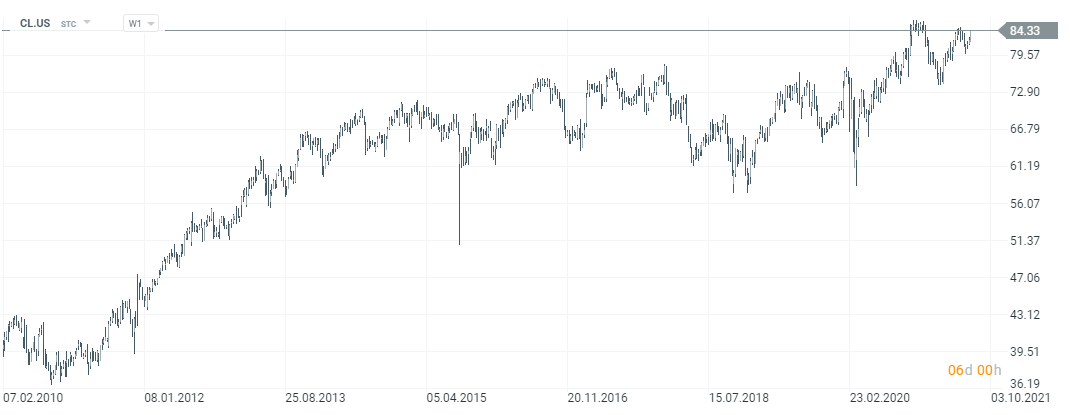
Colgate - Palmolive Chart, W1. Source: xNUMX XTB.
McDonald's
The company owns one of the most famous brands on the catering market. The McDonald's brand has become a "symbol" of fast-food. The history of the company dates back to 1940, when the first restaurant was founded by Richard and Maurice McDonalds. In 2018, it was the second largest private employer in the United States (the first was Walmart).
McDonald's restaurants are present in most countries of the world. It operates in 120 countries and provinces around the world. At the end of 2020, the company had approximately 39 restaurants. Of which 100 in the United States. It should be remembered that over the last decade, the company has started to focus more on the franchise network. At the end of 13, 800% of the restaurants operated on a franchise basis. This reduces revenues, but improves the operating margin.
| $ million | 2017 | 2018 | 2019 | 2020 |
| revenues | 22 820 | 21 025 | 21 076 | 18 865 |
| Operational profit | 8 392 | 8 626 | 8 955 | 7 124 |
| Operating margin | 36,77% | 41,03% | 42,49% | 37,76% |
| Net profit | 5 192 | 5 924 | 6 025 | 4 731 |
| EPS ($) | 6,43$ | 7,61$ | 7,95$ | 6,35$ |
| DPS ($) | 3,83$ | 4,19$ | 4,73$ | 5,04$ |
| Payout ratio | 60% | 55% | 59% | 79% |
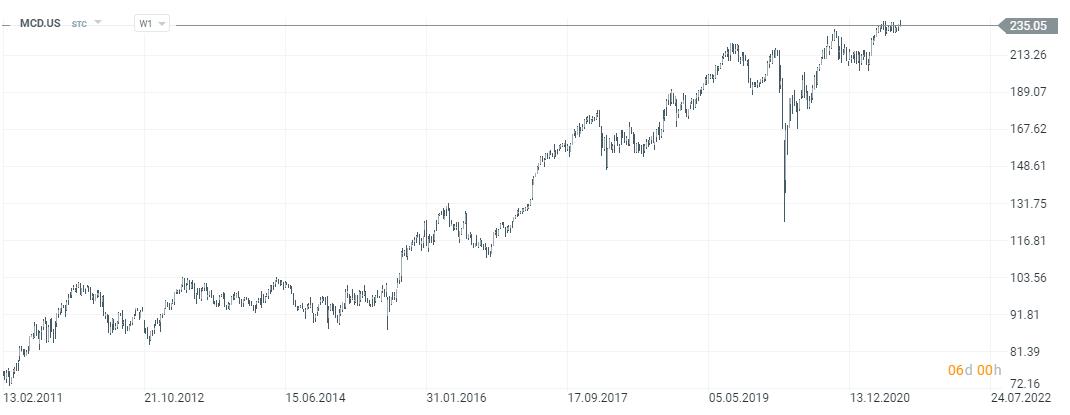
McDonald's chart, interval W1. Source: xNUMX XTB.
S&P Global
The company owns the S&P rating agency, which belongs to the "Big Three", which controls over 90% of the rating agency market. In addition, the company is also the largest shareholder (over 70% of shares) in S&P Dow Jones Indices LLC, which deals with the supply, updating and licensing of benchmark indices for many markets (stocks, commodities, ESG, etc.). It owns, among others, indices from the S&P family (also the most popular product - S&P 500). S&P Global Inc. it also has a segment responsible for providing information and prices on the raw materials market (S&P Global Platts). In November 2020, the company submitted an offer to acquire a 68% stake in IHS Markit. The deal was valued at $ 44 billion.
| $ million | 2017 | 2018 | 2019 | 2020 |
| revenues | 6 063 | 6 258 | 6 699 | 7 442 |
| Operational profit | 2 751 | 2 961 | 3 159 | 3 867 |
| Operating margin | 45,37% | 47,32% | 47,16% | 51,96% |
| Net profit | 1 496 | 1 958 | 2 123 | 2 339 |
| EPS ($) | 5,84$ | 7,80$ | 8,65$ | 9,71$ |
| DPS ($) | 1,64$ | 2,00$ | 2,28$ | 2,68$ |
| Payout ratio | 28% | 25,6% | 26% | 27% |

S&P Global chart, interval W1. Source: xNUMX XTB.
Sherwin-Williams
The company was founded in 1866. It currently operates in over 120 countries and has approximately 4 stores. Sherwin-Williams employs over 770 people. The company produces, distributes and sells paints, primers, sealants, adhesives and wood preservatives. The company's products are intended for both professionals and "home" users. The company sells its products mainly in North America, Latin America, Europe, Asia-Pacifik. The brands include Valspar, Dutch Boy and Pratt & Lambert. The company's capitalization is currently over $ 61 billion.
| $ million | 2017 | 2018 | 2019 | 2020 |
| revenues | 14 984 | 17 535 | 17 901 | 18 362 |
| Operational profit | 1 715 | 1 870 | 2 392 | 2 858 |
| Operating margin | 11,45% | 10,66% | 13,33% | 15,56% |
| Net profit | 1 728 | 1 109 | 1 541 | 2 030 |
| EPS ($) | 6,20$ | 3,97$ | 5,60$ | 7,48$ |
| DPS ($) | 1,13$ | 1,15$ | 1,51$ | 1,79$ |
| Payout ratio | 18% | 29% | 27% | 24% |
Brown-Forman
It is one of the largest companies operating on the alcohol market. The company specializes in spirits (whiskey, vodka, tequila). Brown & Forman is the owner of brands such as Jack Daniel's, Old Forester and Glenglassaugh. The Jack Daniel's brand is particularly important, as it has been classified as the 3rd most valuable alcohol brand in the world. The company's portfolio also includes the Finlandia vodka brand. The most important market for the company is the United States, which generated about half of its revenues in the financial year 2020. The company's capitalization is less than $ 34 billion.
| $ million | 2018FY | 2019FY | 2020FY | 2021FY |
| revenues | 3 248 | 3 324 | 3 363 | 3 461 |
| Operational profit | 1 030 | 1 116 | 1 113 | 1 016 |
| Operating margin | 31,71% | 33,57% | 33,10% | 29,36% |
| Net profit | 717 | 835 | 827 | 903 |
| EPS ($) | 1,49$ | 1,74$ | 1,73$ | 1,89$ |
| DPS ($) | 0,61$ | 0,65$ | 0,68$ | 0,71$ |
| Payout ratio | 41% | 37% | 39% | 38% |

Brown-Forman chart, interval W1. Source: xNUMX XTB.
P & G
The history of the company dates back to 1837, the company's headquarters are in Cincinati. It is one of the largest companies in the world with many well-known consumer brands. The company specializes in the production and sale of cosmetics, personal care products, household chemicals and children's products. The brand portfolio includes Head & Shoulders, Old Spice, Braun, Gillette, Oral-B, Ariel, Fairy, Always and Pampers. Interestingly, the company in the years 1968 - 2012 owned the Pringles brand (snacks), sold it for 2,7 billion dollars to Kellogg. The company's capitalization is $ 344 billion.
| $ million | 2017 | 2018 | 2019 | 2020 |
| revenues | 65 058 | 66 832 | 67 684 | 70 950 |
| Operational profit | 13 766 | 13 363 | 14 354 | 16 172 |
| Operating margin | 21,16% | 19,99% | 21,20% | 22,79% |
| Net profit | 15 326 | 9 750 | 3 897 | 13 027 |
| EPS ($) | 5,80$ | 3,75$ | 1,45$ | 5,13$ |
| DPS ($) | 2,70$ | 2,79$ | 2,90$ | 3,03$ |
| Payout ratio | 47% | 74% | 200% | 59% |
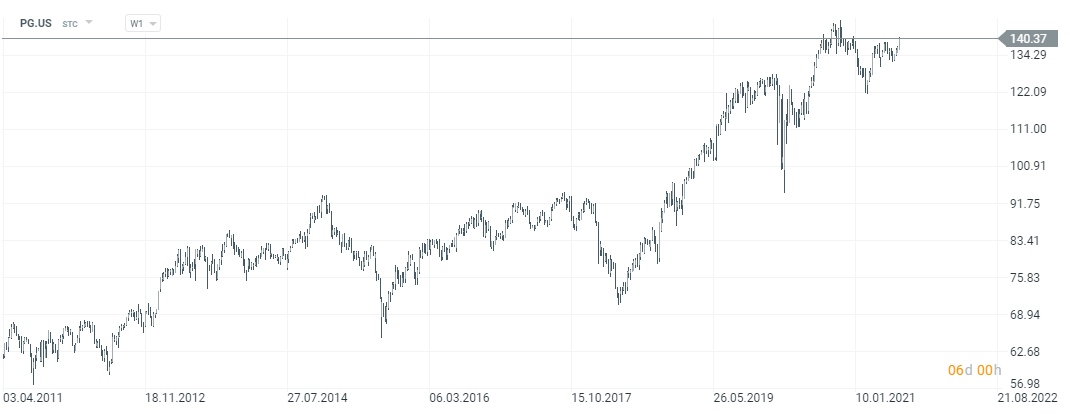
P&G chart, interval W1. Source: xNUMX XTB.
Dividend aristocrats - where to buy shares
Below is a list of selected offers Forex brokers offering an extensive stock offer, with access to companies classified as dividend aristocrats.
| Broker |  |
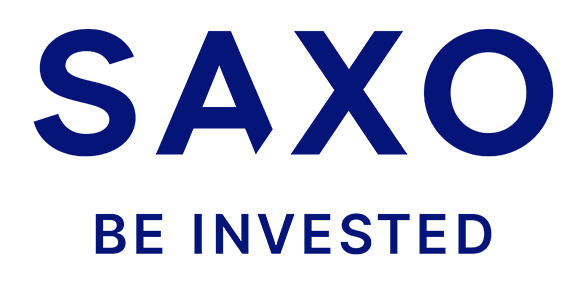 |
|
| End | Poland | Denmark | Poland |
| Shares on offer | approx. 3500 - shares approx. 2000 - CFDs on stocks 16 exchanges |
19 - shares 8 - CFDs on stocks 37 exchanges |
approx. 1 - stocks + CFDs on stocks 5 exchanges |
| Min. Deposit | PLN 0 (recommended min. PLN 2000 or USD 500, EUR) |
0 PLN / 0 EUR / 0 USD | PLN 0 |
| Platform | xStation | SaxoTrader Pro Saxo Trader Go |
MetaTrader 5 |
CFDs are complex instruments and come with a high risk of losing money rapidly due to leverage. From 72% to 89% of retail investor accounts record monetary losses as a result of trading CFDs. Think about whether you understand how CFDs work and whether you can afford the high risk of losing your money.
ETFs with exposure to dividend aristocrats
An investor can look for several dozen companies that meet the criteria of dividend aristocrats. By expanding the range of companies to include those outside the S&P 500 index, their number increases to over 100. If selecting the best companies among them is troublesome for the investor, it is possible to take advantage of the offer ETFs that give exposure to either all dividend aristocrats or meet certain criteria.
SPDR S&P Dividend ETF
It is an ETF designed to mimic the S&P High Yield Dividend Aristocrat Index. The ETF consists of 113 companies that are a component of the S&P 1500 index (it groups the S&P 500, S & P 400 and S&P 600). The ETF can only include companies that have increased dividends for 25 consecutive years. Currently, assets under management amount to $ 19,6 billion. The management fee (TER) is 0,35% per annum. ETF components include such companies as AT&T, Amcor, IBM and Chevron.
ProShares S&P 500 Dividend Aristocrat
This ETF mimics the behavior of the S&P 500 Dividend Aristocrat index. The ETF consists of 65 companies with an average capitalization of $ 83,4 billion. As with the previous ETF, only companies that have paid out and increased dividends each year over the past 25 years can be components. Assets under management (AUM) were approximately $ 2021 billion at the end of March 7,8. The management fee (TER) is 0,35% per annum. ETF components include such companies as Nucor, Caterpillar, General Dynamics or Automatic Data Processing.
SPDR S&P Euro Dividend Aristocrats
It is a specific product. It groups European companies that have been increasing dividends over the past 10 years. It is therefore much "lighter" requirements than the American dividend aristocrats. Since the fund was founded (2012), the average annual rate of return has been 8%. The ETF consists of 40 companies. German (24%), French (18%) and Finnish (18%) companies dominate. The components of the ETF include Allianz, Bouygues, Enagas and Sanofi. The management fee is 0,3% per annum.
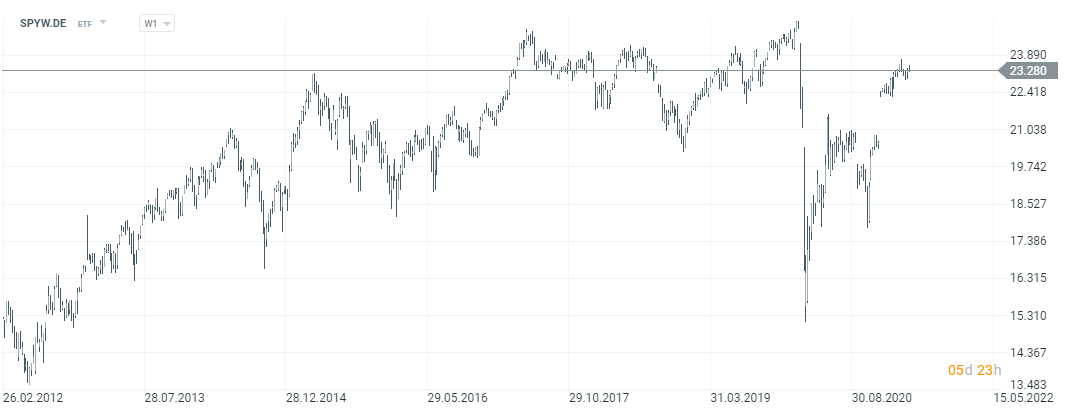
ETF SPDR S&P Chart Euro Dividend Aristocrats interval W1. Source: xNUMX XTB.
Brokers offering ETFs - Dividend aristocrats
| Broker |  |
 |
 |
| End | Poland | Denmark | Great Britain |
| The amount of ETF on offer | 194 - ETF 112 - ETF CFDs |
3000 - ETF 675 - ETF CFDs |
397 - ETF CFDs |
| Min. Deposit | PLN 0 (recommended minimum PLN 2000) |
0 PLN / 0 EUR / 0 USD | PLN 5 |
| Platform | xStation | SaxoTrader Pro Saxo Trader Go |
MetaTrader 5 |
CFDs are complex instruments and come with a high risk of losing money rapidly due to leverage. From 74% to 89% of retail investor accounts record monetary losses as a result of trading CFDs. Think about whether you understand how CFDs work and whether you can afford the high risk of losing your money.
Dividend Aristocrats: Summary
Dividend aristocrats are an interesting choice for investors who prefer to invest in stable companies with an established market position. The investor receives a regular dividend, which is increasing every year. At the same time, companies operating in this way are mature companies with an established market position. However, it should be remembered that "every company is different". This means that sometimes the status of a dividend aristocrat is enjoyed by companies that have had problems with increasing and maintaining the growing dividend in recent years. A good indicator describing the "generosity" of the board is the payout ratio, which informs you what part of the profit is allocated to dividends. The higher the ratio, the greater the risk of ceasing to raise the dividend. It should also be remembered that dividends are the least tax-favorable solution to return capital to shareholders. Purchases of shares are much more advantageous (especially when the market price of shares is lower than the internal value of the company), because it reduces the effective tax rate of the investor (it may postpone it in time until the share is sold).






















![Forex Club – Tax 9 – Settle tax on a foreign broker [Download the Application] Forex Club - Tax 9](https://forexclub.pl/wp-content/uploads/2024/02/Forex-Club-Podatek-9-184x120.jpg?v=1709046278)
![Trading View platform – solutions tailored to the needs of traders [Review] trading view review](https://forexclub.pl/wp-content/uploads/2024/03/trading-view-recenzja-184x120.jpg?v=1709558918)
![How to connect your FP Markets account to the Trading View platform [Guide] fp markets trading view](https://forexclub.pl/wp-content/uploads/2024/02/fp-markets-trading-view-184x120.jpg?v=1708677291)
![How to invest in ChatGPT and AI? Stocks and ETFs [Guide] how to invest in chatgpt and artificial intelligence](https://forexclub.pl/wp-content/uploads/2023/02/jak-inwestowac-w-chatgpt-i-sztuczna-inteligencje-184x120.jpg?v=1676364263)


![WeWork – the anatomy of the collapse of a company valued at $47 billion [WeWork, part II] wework bankruptcy story](https://forexclub.pl/wp-content/uploads/2024/04/wework-bankructwo-historia-184x120.jpg?v=1711729561)
![Adam Neumann – the man who screwed up Softbank [WeWork, part AND] adam neumann wework](https://forexclub.pl/wp-content/uploads/2024/04/adam-neumann-wework-184x120.jpg?v=1711728724)





![How to transfer shares to another brokerage office [Procedure description] how to transfer shares to another brokerage house](https://forexclub.pl/wp-content/uploads/2024/03/jak-przeniesc-akcje-do-innego-biura-maklerskiego-184x120.jpg?v=1709556924)

![The most common mistakes of a beginner trader - Mr Yogi [VIDEO] Scalping - The most common mistakes of a beginner trader - VIDEO](https://forexclub.pl/wp-content/uploads/2024/03/Scalping-Najczestsze-bledy-poczatkujacego-tradera-VIDEO-184x120.jpg?v=1711601376)
![Learning patience: No position is also a position - Mr Yogi [VIDEO] Scalping - Learning patience - No position is also a position - VIDEO](https://forexclub.pl/wp-content/uploads/2024/03/Scalping-Nauka-cierpliwosci-Brak-pozycji-to-tez-pozycja-VIDEO-184x120.jpg?v=1710999249)
![When to exit a position and how to minimize losses - Mr Yogi [VIDEO] Scalping - When to exit a position and how to minimize losses - VIDEO](https://forexclub.pl/wp-content/uploads/2024/03/Scalping-Kiedy-wyjsc-z-pozycji-i-jak-minimalizowac-straty-VIDEO-184x120.jpg?v=1710336731)


![Dividend Aristocrats - buy, keep and earn [Guide] dividend aristocrats](https://forexclub.pl/wp-content/uploads/2021/07/dywidendowi-arystokraci.jpg?v=1626680128)

![How to invest in ChatGPT and AI? Stocks and ETFs [Guide] how to invest in chatgpt and artificial intelligence](https://forexclub.pl/wp-content/uploads/2023/02/jak-inwestowac-w-chatgpt-i-sztuczna-inteligencje-300x200.jpg?v=1676364263)

![Dividend Aristocrats - buy, keep and earn [Guide] KNF, Polish Financial Supervision Authority](https://forexclub.pl/wp-content/uploads/2017/05/knf-102x65.jpg?v=1598173284)
![Dividend Aristocrats - buy, keep and earn [Guide] Changpeng Zhao binance letter](https://forexclub.pl/wp-content/uploads/2021/07/Changpeng-Zhao-binance-letter-102x65.jpg?v=1626681795)









